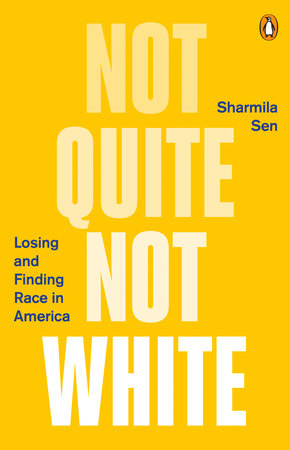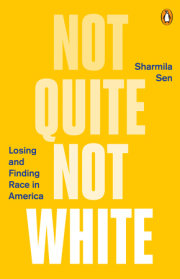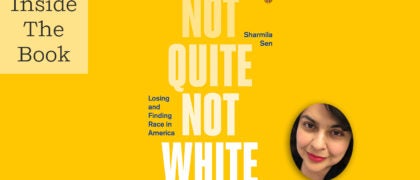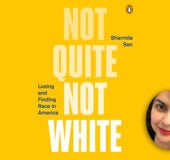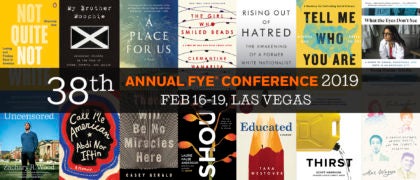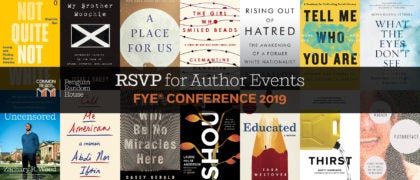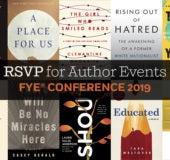Chapter One
Enter the Dragon
I had never seen a black man in person until I was twelve years old. If I search my memory hard enough, I can see a few faded newspaper photographs of West Indian cricketers in the Statesman. I can see dark-skinned Africans within the panels of my beloved Phantom comics. There are faint recollections of black James Bond villains in Live and Let Die. If I squint even more, I can remember the evening when we crowded into our neighbor's drawing room, watching PelŽ on a black-and-white television set, the first procured in our middle-class neighborhood. The first flesh-and-blood black man I saw was standing outside the entrance to the U.S. consulate in Calcutta, which is located on a street named after Ho Chi Minh. At the entrance to the consulate where Ma, Baba, and I had gone for our visa interviews, I saw two men in spotless uniforms. One was the whitest, blondest man I had ever seen in real life; the other was the darkest black.
The consulate smelled like America in my childish imagination. The air-conditioned halls, the modern plastic and metal furniture, a water cooler from which I eagerly poured myself some water even though I was not thirsty. I breathed in the scent of wealth in there. It felt like newness on my skin. Everything was hushed, ordered, brightly lit. Not like my own loud, bustling city. Even the local Indian staff seemed to behave as if they were actually living in America.
I stood at the entrance of the U.S. consulate in Calcutta in 1982. In 1965, American immigration laws had been rewritten to allow for a greater number of non-Europeans to enter the country. Not only were Indians and other Asians considered unwanted newcomers before 1965, even naturalization-the process by which a foreign-born immigrant becomes a U.S. citizen-was disallowed for most who were not white until the 1950s. I knew little of this history when I entered the consulate with my parents. I did not even know I had something called race. Race as a category had not been part of the Indian census since 1951. I was about to move to a nation where nearly every official form had a section in which I would be offered an array of racial categories and expected to pick one.
In 1982, as it happens, it was not clear which race should be affixed to my person. Since the number of Indian immigrants was fairly insignificant in the United States until the latter part of the twentieth century, the census barely took notice of us. At time of the first U.S. census in 1790, there were essentially three races acknowledged by the government-white, black, and Indian. My kind of Indians, the ones from the subcontinent, however, fell into none of these categories. No matter how mysterious our race, we were not considered white during most of the nineteenth and twentieth centuries by the American courts. In 1970, the U.S. Census Bureau declared people from India to be legally white. A decade later, in 1980, we were officially reclassified as Asian by the government, at the insistence of Indian immigrant groups who believed that the new classification would afford us greater affirmative action benefits. Yet, what was to be done with the decision to make Indians white only a decade earlier? What would happen to those white Indians? "Self-reporting" was the Solomonic solution to this problem. In order to satisfy the demands of the diverse Indian community, after nearly a century of shuffling people from the Indian subcontinent from one racial category to another, the U.S. census had finally thrown up its hands in despair and asked us to "self-report" our race. In the 1990 U.S. census, of the native-born population with origins in the Indian subcontinent, nearly a quarter reported themselves to be white, a tiny minority (5 percent) reported themselves to be black, and the vast majority chose to report their race using terms that pertain to South Asia.
Such an astounding array of choices was not always available to people from India who found themselves in the United States a century ago. If Ma, Baba, and I could have embarked on a time machine and arrived in the country eight decades earlier, we would have found ourselves in a different situation. If I had immigrated in 1909, I would have been labeled "probably not white," but a year later-when the U.S. courts decided to change their opinion on the matter-I would have been "white." If I was Sadar Bhagwab Singh in 1917, or Akhay Kumar Mozumdar in 1919, or Bhagat Singh Thind in 1923, I would have been "not white." Naturalization in the United States was reserved mostly for whites between 1790 and the middle of the twentieth century. Non-white immigrants could not become naturalized and partake of the rights reserved for U.S. citizens. Indians were not allowed to become naturalized citizens until the 1940s. They could, however, toil in American factories and fields, offices and streets. So Indian men such as Mozumdar, Singh, and Thind kept trying in vain to prove they were white in order to become naturalized citizens. But what actually made a person "white"? Could you be both "Caucasian" and "non-white"? As Mozumdar, Singh, and Thind all found out, yes, you could be Caucasian and also Not White. The courts ruled repeatedly in those early decades of the twentieth century that naturalization was for "whites" only, and some "Caucasians" were not truly "white" enough to qualify.
That the two words-Caucasian and white-are used interchangeably today would come as a bittersweet surprise to all who were caught in the deep chasm between those labels a century ago. Yet, that is exactly the chasm in which people from the Indian subcontinent, an area that is second only to Africa in its genetic and linguistic diversity, were placed by the U.S. courts. In those early years of the twentieth century, miscegenation laws could have prevented me from marrying a white American in states such as South Carolina, Georgia, and Virginia. The former governor of South Carolina and the current U.S. ambassador to the United Nations, Nikki Haley, identifies herself as "white" on her voter registration card. Of course, according to the laws of this country, Haley can legally self-report her race any way she pleases. The former governor of South Carolina was born Nimrata Nikki Randhawa, daughter of Punjabi Sikh immigrants from India, and the racial category she chooses for herself tells a complex story of the state where the first shots of the Civil War were fired, and where even today West African-inflected Gullah culture (brought by black slaves) does not easily mix with white French Huguenot culture (brought by white slave owners).
A hundred years ago Indians immigrated to the United States in very small numbers. They were mostly agricultural workers who traversed the networks of the British Empire, sailors who stayed behind in American ports, or Hindu holy men who were invited to lecture in cities such as New York and Chicago. The Immigration Act of 1917 placed India squarely within the Asiatic Barred Zone, an area from which immigrants were not allowed to legally enter the United States. This zone would not be legally unbarred until 1946.
Contemporary racial labels used in everyday American parlance are an odd amalgamation of the geographic (Asian), the linguistic (Hispanic), and the pseudo-biological (black, white). The rise of Islamophobia threatens to racialize Islam and conflates race with religion. This, however, is not a new phenomenon in American history. Early-twentieth-century America was still in the old habit of seeing Jews as "Hebrews"-as much a racial label as a religious one. It also happened that many Jews themselves preferred this system-until the murderous actions of the Nazis in Europe-because Judaism cannot be folded neatly into the box we call "religion" today, a box whose dimensions are largely of Protestant specifications. Similarly, "Hindoo" was as much a racial label as a religion in early-twentieth-century America. Today what is considered my religious background might have been seen as my racial identity had I arrived in America at the beginning of the last century.
The Immigration and Nationality Act of 1965, signed by Lyndon B. Johnson, changed the quota system that restricted non-European immigrants from coming to the United States. People like me were going to become a bit more common on American soil. Hindoo, Asiatic, Caucasian, non-white, brown, Asian, South Asian. During the era of self-reporting in the early 1980s, I was a young girl faced with a plethora of racial categories based on a wild mash-up of genetics, linguistics, theology, and geography, who landed in Boston on August 11, 1982. The entry date is marked on my first passport.
I carried an Indian passport back then. Navy blue with thick cardboard covers. I received that passport in December 1979. On page four, there is a line printed in minuscule letters: "Countries for which this Passport is valid." Below it a stamp, in purplish blue ink, slightly tilted, partly smudged, is still vividly legible after nearly forty years. It says (first in Hindi): "sabhi desh dakshin afrika aur rodeshiya ko chhorkar-ALL COUNTRIES Except Republic of South Africa and Colony of Rhodesia."
Before immigrating to the United States, I had never left India. My 1979 passport was an aspirational possession. Yet, I was already becoming aware of certain countries that were forbidden to me. My parents explained that India did not allow me to travel to South Africa or Rhodesia because of something called apartheid. There existed places where people like us had gone as coolie labor, as merchants and traders, and even as lawyers (the young Mahatma Gandhi practiced law in Pretoria in the 1890s), during the time of the British. But white people did not treat brown and black people fairly and each group had to live apart. Unlike my forebears who had borne the "malodorousness of subjecthood" for two centuries-as the Indian political scientist Niraja Jayal once wrote-I was fragrant with citizenship and protected by the laws of my nation. And those laws prevented me from going to Rhodesia and South Africa, places where complex designations such as black, colored, Indian, and white would determine where I could live, where I could go to school, and who I could marry. But in the late 1970s, when I received my passport, I barely grasped what apartheid really meant.
Caucasian but Not White. Not White and Not Black. Minority. Non-Christian. Person of Color. South Asian. I never thought of myself as any of these things before the autumn of 1982. I had grown up back in Calcutta with an entirely different set of extended labels for putting people into boxes. What language do you speak? Which gods do you worship? Which caste do you belong to? Are you part of the bhadralok (the Bengali word for the bourgeoisie)? Do you eat with relish the flesh of animals, fowl, fish, and crustaceans? Do you eat beef? Or do you eat only plants and grains? "Veg" and "Non-veg" in India are almost as evocative and important as "black" and "white" in America. We can detect a person's religion, caste, ethnic group from the foods they eat and the foods they shun. Every society invents ways of partitioning themselves and methods of reading the hidden signs displayed by those who wish to cheat the rules. A person of a lower caste might want to pass as a Brahmin; a Muslim might want to pretend to be a Hindu when caught in the middle of a riot; a Hindu might pose as a Muslim to gain entry to a restricted space. We were taught to be vigilant about such trespassers. An Indian's surname holds a multitude of information about her. In India, if you know my surname is Sen, you already know which language I speak as my mother tongue, my caste, the religious holidays I celebrate, my likely economic class, my literacy status, whether I am vegetarian, the birth, wedding, and funeral rites I might have. Conversely, a last name that holds very little information is suspect. What is this person trying to hide? The way one pronounces a certain word, the way a woman drapes her dupatta over her head, how her nose is pierced, whether a man's foreskin is intact or circumcised, whether a little boy has a red thread around his wrist or a tabeez, an amulet, around his neck signifies so many things in India. In some cases, it can mean the difference between being killed by a mob during a communal riot and being pulled into safety. We had all these distinguishing labels. But race we did not have.
¥ ¥ ¥
I grew up in India for the first twelve years of my life without race. After ruling us for two centuries, the British had departed in 1947. The India of my childhood was a place marked by what economists call "capital flight." These were years preceding the arrival of economic liberalization. Before the Internet and cheap cell phones, our knowledge of the United States was channeled largely by a few Hollywood movies, occasional headlines in the newspapers, magazines such as Life and Reader's Digest, and hand-me-down clothing brought back by relatives who had emigrated to the West. Television had not fully arrived in India during the first half of the 1970s. We tried halfheartedly to imitate American fashion, eat American fast food, or listen to American popular music. Still, we were always a few years behind on the trends. Of course, we were also happy with our own popular culture. We watched Hindi films made in Bombay, hummed along to the songs aired on All India Radio, and ate delicious street foods such as phuchka and jhalmuri without missing global chains such as KFC or McDonald's. Our drinking water was procured daily from the neighborhood tube well. Ma, Baba, and I each had our own official ration cards. These rations cards were used for purchasing government-subsidized basic commodities-rice, flour, sugar-which we used to complement our groceries from the local bazaars. I had never seen a mall or a supermarket before I came to the United States. Ma and Baba did not own a telephone, a washing machine, a television, a cassette player, a car, or a credit card until we emigrated. Our sole mode of personal transportation was a blue Lambretta scooter purchased by Baba in the mid-1970s. When Baba was not around to take us around on the scooter, hand-pulled rickshaws, red double-decker buses, trams, and the occasional taxi were the usual ways we navigated the sprawling metropolis that was Calcutta.
We vaguely understood ourselves to be Not White because our grandparents and parents still remembered a time when white Europeans ruled us. The Indian notion of Not Whiteness was shaped more by nationalism than by race talk. The subcontinental obsession with skin color cannot be explained solely through the American grammar of racism. In a subcontinent where melanin can appear in wildly differing quantities among family members, the lightness or darkness of one's skin cannot easily be used to mark rigid racial boundaries. Yet, the preference for paler skin was clear to all in Calcutta. Girls with "fair" skin were supposed to fare better than those with "wheatish" or "dark" skin when marriages were to be arranged. I grew up reading numerous sentimental tearjerkers about sisters whose fates were determined by their complexions-the fair one always married well and the dark one was forever shunned by all prospective bridegrooms. Rabindranath Tagore's famous lyric about the beauty of the black-skinned woman's dark doe eyes was quoted often in literary families, marked by the same self-righteousness with which well-off Americans buy fair trade coffee beans. Still, I never came across a matrimonial advertisement in any newspaper that boasted of a dark-skinned girl's beautiful doe eyes.
Copyright © 2018 by Sharmila Sen. All rights reserved. No part of this excerpt may be reproduced or reprinted without permission in writing from the publisher.

